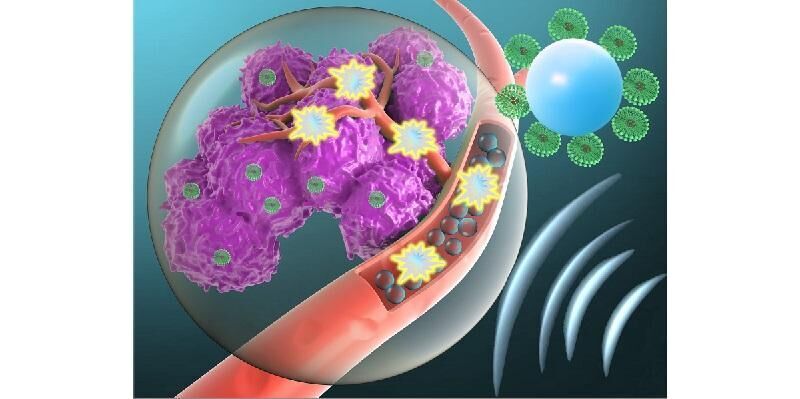
University of Leeds research has shown how microbubbles carrying powerful cancer drugs can be guided to the site of a tumour using antibodies.
Microbubbles are small manufactured spheres half the size of a red blood cell - and scientists believe they can be used to transport drugs to highly specific locations within the body.
The findings from the research are published in the journal Theranostics.
“Microbubbles could allow us to use powerful drugs with precision - that reduces the risk of damaging healthy cells.”
The lead authors, Drs Nicola Ingram and Laura McVeigh from the School of Medicine, describe how they targeted microbubbles through the use of a ‘navigational aid’ - antibodies attracted to the growth hormone found in high levels in the blood vessels supplying a tumour.
The antibodies were attached to the microbubbles. As a result of being attracted to the growth hormone, the microbubbles became concentrated at the site of the tumour. A pulse from an ultrasound device was used to burst open the microbubbles, and that released the anti-cancer agent.
The study was conducted on animals, which were used as a model to try and develop this technique for use in humans.
Dr Ingram said being able to deliver anticancer drugs in a very targeted fashion would be a major advance in cancer therapy.
She added: “One of the big problems with cancer drugs is that they are highly toxic to the rest of the body too. Microbubble technology could allow us to use these very powerful drugs with precision and that reduces the risk of the drug damaging healthy cells nearby.
“It is about finely focused drug delivery.”
The study also revealed that by attaching the drug directly to the microbubbles allowed it to circulate in the body for longer, increasing delivery into the tumour - in effect making the drug more potent.
As a result, the scientists were able to slow cancer growth with a much smaller drug dose.
Professor Stephen Evans, head of the Molecular and Nanoscale Physics Group at Leeds and one of the paper’s authors, said: “The results of this study are exciting because we not only show the very precise and targeted way microbubbles can be guided to cancer sites but that the efficacy of drug delivery is substantially improved, opening the way to use highly toxic drugs to fight cancer, without the harmful side effects.
“Put simply: you get more bang for your buck.”
Watch the video where Professor Evans describes the potential benefit of microbubble technology.
The next stage of the research is to look at using microbubbles to develop targeted, triggered, delivery systems in patients for the diagnosis and treatment of advanced colorectal cancer, the third most common cancer in the UK.
Co-author Professor Peter Simpson, Chief Scientific Officer at Medicines Discovery Catapult said: “Complex medicines have the potential to be the third wave of medicines, addressing patients’ problems which conventionally administered small molecules and monoclonal antibodies cannot.
“This project is a very encouraging example of exploring how using an advanced drug delivery technology could improve biodistribution, targeting and efficacy of a potentially toxic therapeutic.”
This study involved a research team from the universities of Leeds, Bradford, Manchester, and the Medicines Discovery Catapult in Cheshire. The study and a follow-on study were funded by the Engineering and Physical Sciences Research Council. In addition, several PhD students are also developing microbubbles for treatment of other diseases and have been funded by University of Leeds alumni.
Further information
Top graphic: Microbubbles carry the anticancer drug to the site of the tumour. Antibodies attached to the microbubbles are attracted to the growth hormone found around cancer cells. Once in situ, an ultrasound device is used to burst the bubbles, releasing the drug. Image credit: Dr Sunjie Ye, University of Leeds
The University of Leeds has established the Leeds Microbubble Consortium, a group of cancer scientists, engineers, physicists and chemists to develop ways microbubble technology could enhance cancer treatment.